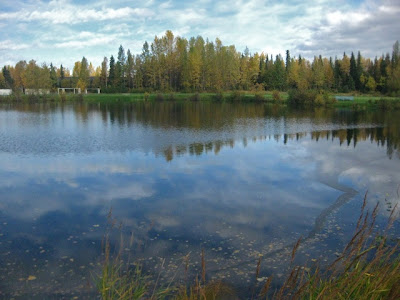 The sun came out for this ceremony. There were construction workers and some DOT employees. A few cyclists and some dogs and walkers. And Channel 2 and Channel 11 and the Anchorage Daily News had camera folks. As well as an unnamed blogger.
The sun came out for this ceremony. There were construction workers and some DOT employees. A few cyclists and some dogs and walkers. And Channel 2 and Channel 11 and the Anchorage Daily News had camera folks. As well as an unnamed blogger. And there were two Muni employees who'd been working to make this happen since 1991 they said. This was the culmination of a lot of work - getting this train connected under the Seward Highway. And now it's done.
It was hard getting good angle without blocking the sun which is already pretty low on the horizon at noon. It says, "East & West Finally Connected."
The absence of anyone of note - mayor, assembly, representatives, even department heads - or any real ceremony was probably fitting. The real workers behind making this happen over the long term were probably the two women who had the cake and the blue lemonade container. Chong Kim, the DOT engineer who has overseen the actual construction, was at a meeting I was told. There was no ceremony and no ribbon cutting even though this is probably the most ambitious individual bike trail construction project in Anchorage since the Coastal trail was built. This connected bike paths that were separated by the Seward Highway and its two access roads. It's true, one could scramble under the old bridges and many did. The top photo has a picture of the old bridge. And here are some before and after shots. But this is a recognition that bike paths do matter.

There are still some things to work on - crossing Lake Otis for example. Crossing Dowling was finished this summer. But this was the biggie - four bridges under a major highway and access roads. One of the women there from Anchorage Public Works told me there was a $10 million estimate for a similar underpass at Lake Otis. She smiled wryly when I suggested they use the $20 million allocated to bulldoze Elmore through the University land, a project only the engineers seriously want and all the people living near by strongly oppose. Money that was put into the state budget in the very last minutes before the state budget was passed this year in Juneau. Over the opposition of all the state and local representatives of the area.
It's hard to take a picture of something that isn't there. Until yesterday, there was a fence blocking this bridge right here. For me, the removal of the fence is the real opening of this trail.
Here's what it looked like earlier this week.
These are snow fences to protect the trail and trail users from snow being plowed from the road above. Technically, they aren't supposed to plow snow from the highway into the creek anyway, but just in case, and to keep other debris falling from the highway off the people below.
The construction is still going on. I think they may still need to connect the bike trail on the road above to the bike trail, but it seems it would make sense to do it from the same side of the creek as the trail. So, I'm not sure what they are doing here.
And this last shot is from the bridge east of the highway where the fence was removed yesterday. The cake table is just on this side of the bridge.





















































